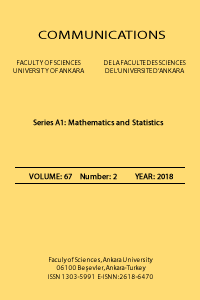A regression type estimator for mean estimation under ranked set sampling alongside the sensitivity issue
___
- Bouza, C. N., Ranked set sampling for the product estimator, Rev. Invest. Oper. 29(3), (2008), 201--206.
- Diana, G. and Perri, P.F., New scrambled response model for estimating the mean of a sensitive quantitative character, Journal of Applied Statistics 37,(2010), 1875--1890.
- Eichhorn, B. and Hayre, L.S., Scrambled randomized response method for obtaining sensitive quantitative data, Journal of Statistical Planning and Inference 7, (1983), 307--316.
- Gupta, S., Shabbir, J., Sousa, R. and Corte-Real, P., Estimation of the mean of a sensitive variable in the presence of auxiliary information, Communications in Statistics-Theory and Methods 41, (2012), 2394--2404.
- Kadilar,C., Unyazici,Y. and Cingi,H., Ratio estimator for the population mean using ranked set sampling, Statist. Papers 50, (2009), 301--309.
- Koyuncu, N., Gupta, S. and Sousa, R., Exponential-type estimators of the mean of a sensitive variable in the presence of nonsensitive auxiliary information, Communications in Statistics - Simulation and Computation 43(7), (2014), 1583--1594.
- Koyuncu, N. and Kadilar, C., Efficient estimators for the population mean, Hacett. J. Math. Statist. 38(2),(2009), 217--225.
- McIntyre, G.A., A method for unbiased selective sampling using ranked sets, Australian Journal of Agricultural Research 3, (1952), 385--390.
- Mehta, N. and Mandowara, V., A modified ratio-cum-product estimator of finite population mean using ranked set sampling, Communications in Statistics-Theory and Methods 45(2), (2016), 267--276.
- Pollock, K.H. and Bek, Y., A comparison of three randomized response models for quantitative data, Journal of the American Statistical Association 71,(1976), 884-886.
- Saha, A., A randomized response technique for quantitative data under unequal probability sampling, Journal of Statistical Theory and Practice 2(4),(2008), 589--596.
- Samawi, H. M. and Muttlak, H. A., Estimation of ratio using rank set sampling, Biomet. J. 38, (1996), 753--764.
- Shahzad, U., On the estimation of population mean under systematic sampling using auxiliary attributes, Orient J Phys Sciences 1, (2016), 17--22.
- Singh, H. P. and Kakran M. S., A modified ratio estimator using known coefficient of kurtosis of an auxiliary character, In Singh, S. ed. Advanced Sampling Theory with Applications, Kluwer Academic Publishers,(1993).
- Singh, H.P., Tailor, R. and Singh, S., General procedure for estimating the population mean using ranked set sampling, Journal of Statistical Computation and Simulation 84(5), (2014), 931--945.
- Singh, S., Advanced Sampling Theory with Applications. Vol. 1 and 2. London: Kluwer Academic Publishers,(2003).
- Sisodia, B. V. S. and Dwivedi, V. K., A modified ratio estimator using coefficient of variation of auxiliary variable, J. Ind. Soc. Agri. Statist. 33, (1981), 13--18.
- Sousa, R., Shabbir, J., Corte-Real, P., Gupta, S. , Ratio estimation of the mean of a sensitive variable in the presence of auxiliary information, Journal of Statistical Theory and Practice 4(3),(2010), 495--507.
- Tailor, R., Sharma, B., A modified ratio-cum-product estimator of finite population mean using known coefficient of variation and coefficient of kurtosis. Stat. Transition New Ser. 10(1),(2009),15--24.
- Upadhyaya, L. N., Singh, H. P., Use of transformed auxiliary variable in estimating the finite population mean, Biometrical J. 41, (1999), 627--636.
- ISSN: 1303-5991
- Yayın Aralığı: Yılda 4 Sayı
- Başlangıç: 1948
- Yayıncı: Ankara Üniversitesi
Esin KÖKSAL BABACAN, Samet Kaya
A. M. ALOTAİBİ, M. S. M. NOORANİ, M. A. EL-MONEAM
Adara M. BLAGA, Selcen Yüksel PERKTAŞ
Mehmet AYDİNALP, Mustafa KAZAZ, Hasan Hüseyin UĞURLU
Automatic structure for generalized Bruck-Reilly ∗-extension of a monoid
